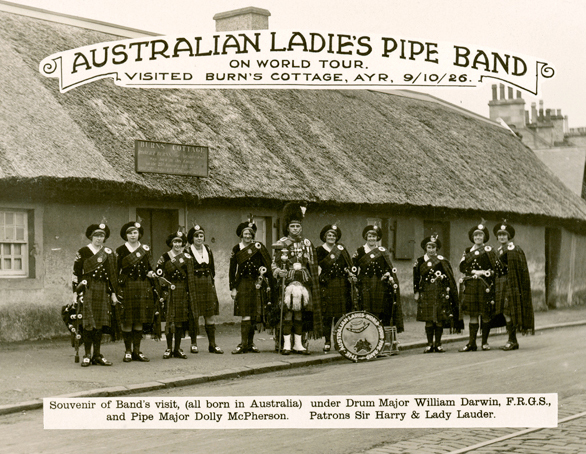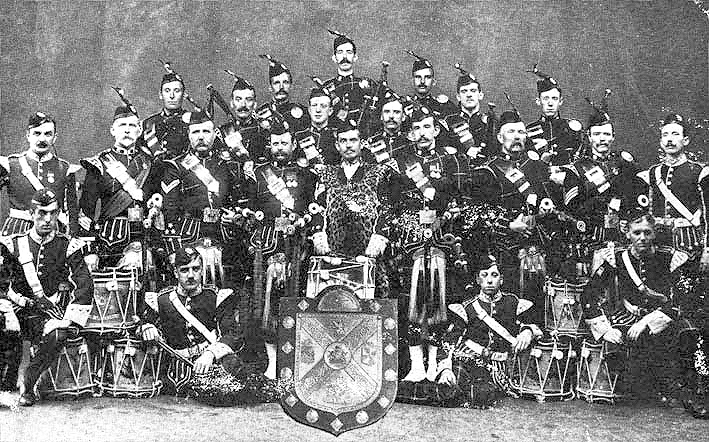We conclude our look at pipe band history with another instalment from piping historian Jeannie Campbell. This article first appeared in PIpe Band Magazine in 2003…
The first pipe bands outside the Army date from the 1880s. A tune named the ‘Midlothian Amateur Pipe Band’ was published in David Glen’s Tutor in 1881 so presumably there was a band of that name at the time. The Govan Police Pipe Band [pictured top] was one of the earliest civilian bands. It was formed in about 1883 under Pipe Major William Bremner who was followed in 1890 by Pipe Major Drysdale. [Listen to a historic recording of Govan Police band here; this is probably the first ever recording of a pipe band]
In 1898 Alistair Hutcheon became the pipe major. He was born in Ellon, Aberdeenshire, in 1862, joined the Scots Guards and served in the Egyptian campaign in 1882. When he left the Army he joined the Govan police force and by 1891 was a police constable. He was described as an excellent piper and teacher whose enthusiasm for piping infected everyone connected with him. The band uniform was a dark blue doublet worn with kilt, plaid and hose of hodden grey with a purple stripe. It was a common sight in the 1890s to see the pipers and dancers being conveyed to functions in a four in hand coach drawn by grey horses.[wds id=”6″]The average height of the band members at the time was 6 feet 2 and a half inches so they would have been an impressive sight. In 1912 when Govan became part of Glasgow, the band became the Glasgow Police Pipe Band and changed to the Royal Stewart tartan. The Edinburgh Police Pipe Band first came into existence in 1882 as part of the Edinburgh Municipal band with a drum section drawn from the Gas and Transport departments. About 1890 it was reorganised as the Edinburgh City Police Pipe Band.
The Wallacestone Pipe Band founded in 1887 was one of the first truly civilian bands having no connection with the police or the army. Another early band was the Colinton and Currie band also founded in 1887. The Inveraray Pipe Band was known to be in existence by 1890. The Coalburn Rechabite pipe band was founded in 1894 during a miners’ strike. The men were unemployed for 13 weeks during the summer so one of their number began to teach the others. The band actually came into being in 1898.
The first civilian band in England was perhaps the Accrington St John’s Ambulance Pipe Band formed in 1898. The Boys Brigade was founded in Glasgow in October 1883 and quite soon had started pipe bands in its various companies. The history of Boys’ Brigade piping could fill a whole article so is not covered here. One of the first pipe band competitions was held at lbrox stadium in the 1890s under the auspices of the Govan Police sports committee. The winners were the Govan Police and among the bands taking part were volunteer battalion bands under Pipe Majors John MacDougall Gillies and Farquhar MacRae.
The next competition was arranged by Glasgow Corporation at Bellahouston and again Govan Police were first. There was another contest at lbrox in 1901; the Govan Police were first and Wallacestone were second. Two bands played. By the turn of the century there were pipe bands in twelve battalions of Highland regiments, eight Scottish regiments, three battalions of the Scots Guards, twenty militia battalions, forty or fifty Volunteer battalions, plus schools, cadets, Boys Brigade and civilian bands. The first World Championship contest was held at the Cowal Gathering in 1906.
There had been solo piping contests at Cowal since the Gathering was first held in 1894 then at a committee meeting in May 1906 a local master mason named Malcolm McCulloch suggested that a pipe band contest should be held at the 1906 Gathering. It was decided that each band comprise not less than eight pipers and not more than twelve, with an optional number of drummers. The prize money was fixed at £10, £5 and £2/10s. Money was raised by public subscription to pay for a shield which cost £43 18s 6d. Queen Victoria’s daughter, Princess Louise, who was married to the Duke of Argyll helped to design the shield which was named the Argyll Shield.[wds id=”2″]This is still the first prize in the Grade One competition at Cowal. At the first contest a total of 17 bands took part. The winners were the 1st Volunteer battalion HLI under P/M John MacDougall Gillies, the Govan Police under P/M Alistair Hutcheon were second and third equal were the 3rd Volunteer Battalion HLI under P/M Farquhar MacRae and the Queen’s Volunteer Battalion Royal Scots. In 1907 Cowal added a contest for juvenile bands and in 1909 another event was added, a contest for civilian bands only.
Many pipe bands were formed in the early years of the century, including Bowhill founded in 1902, Shotts and Dykehead 1906, Stonehouse pre-1909 and Camelon 1913. There were lots of band competitions at this time. During the First World War 1914-18 all contests stopped but re-started again in the 1920s. Today visits to Scotland from overseas bands are a regular occurrence. Perhaps one of the first bands to do a World tour were the Australian Ladies who visited Scotland in 1926 and were photographed outside Burns’ Cottage.

The Championship of Glasgow was held in March 1928, indoors, in the Winter Garden of the Peoples’ Palace on Glasgow Green where the World Championships are held today. Thirteen bands played and each played a test piece slow march and march and then a march, strathspey and reel chosen from three of each submitted. The set tunes were the 74th Slow March and the quick march Brigadier Ronald Cheape of Tiroran for the first part of the contest. In the second part a total of 22 different marches were submitted but the most popular of these were Lord Alexander Kennedy submitted eight times and Highland Wedding submitted five times. Both of these are still popular with bands today.
The most popular strathspeys in 1928 were The Shepherd’s Crook and Tulloch Gorm and the most popular reels were Pretty Marion and Caber Feidh. Each band had between 11 and 14 pipers and five or six drummers including the bass section. There was one adjudicator, Pipe Major J.A. Gordon. The winners at this contest were the Glasgow Police with the Clan MacRae Society second, the Maclean Pipe Band third and Glasgow Tramways fourth. The other bands taking part were the Glasgow Shepherds, the 7th HLI, the 5th HLI, Cameron Pipe Band, St. Rollox Temperance, Clan MacKenzie, Christ Church, Provanside and the 21st Glasgow Rover Scouts.

This competition was an annual event for a number of years during the 1920s and 1930s and winning bands were awarded a number of paid engagements to play in the Glasgow Parks during the summer. At this time anyone could run a pipe band contest and each promoter could make his own rules and his own choice of judges. In 1930 a group of pipe majors got together on the boat returning from the Cowal Games and their discussions led to a meeting in October that year at which The Scottish Pipe Band Association was formed in order to organise and regulate pipe bands and pipe band competitions. The bands were arranged in three grades and the first Association run contest took place at Stirling in June 1933. Other promoters soon began to adopt the Association rules and run contests in three grades. As we hear from old recordings, pipe band performances at that time were a bit more informal than at the present, for example the pipe band start as we know it today, was unknown then and there were no sets of matched chanters.




















Recent Comments